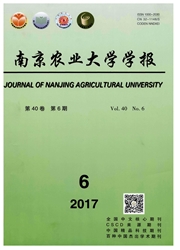

 中文摘要:
中文摘要:
研究了黄瓜自然生长期间叶片可溶性蛋白质降解、内肽酶活性及其同工酶的变化,并对叶片衰老后期粗提液内肽酶的基本生化特性进行了研究。结果表明,黄瓜叶片内肽酶活性在叶片伸出5 d时较低,叶片衰老后期(叶片伸出35d)显著升高,Rub isco蛋白发生明显降解;叶片全展以后叶片蛋白质含量与内肽酶活性显著负相关。黄瓜叶片粗提液总内肽酶的最适pH为7.0,最适温度为40℃,内肽酶活性可被Ca^2+、Zn^2+、半胱氨酸等激活。内肽酶抑制剂试验显示,丝氨酸类型的内肽酶活性占内肽酶总活性的57%左右。采用以明胶为底物的内肽酶梯度凝胶电泳活性染色方法,检测到叶片中至少有4种内肽酶同工酶,各同工酶在叶片生长过程中出现的时间和活性大小不同,丝氨酸型内肽酶同工酶活性随叶片生长明显增强,暗示该类内肽酶在黄瓜叶片衰老过程中可能具有重要作用。
 英文摘要:
英文摘要:
The changes of endopeptidase isoenzymes and their activities of leaves in cucumber ( Cucumis sativus L. ) development were studied. Furthermore, the characters of endopeptidase of cucumber leaves in the late stage of senescence were also investigated. The results showed that the endopeptidase activity was low on 5 d, however, the activity increased significantly on 35 d after leaf came out. Meanwhile, the protein content was negative correlated with the endopeptidases activity since leaf full expanded. The optimum pH and temperature of total endopeptidases in crude extracts were pH 7.0, 40℃. Besides, Ca^2+ , Zn^2+ and cystine could increase the endopeptidase activities. At least four major endopeptidase isoenzymes were observed by gradient polyacrylamide gel electrophoresis (PAGE). Inhibition analysis suggested that the activity of serine endopeptidase isoenzymes was the highest in the all endopeptidases and increased during leaf senescence. It suggested that serine endopeptidases might play an important physiological function in cucumber leaf senescence.
 同期刊论文项目
同期刊论文项目
 同项目期刊论文
同项目期刊论文
 期刊信息
期刊信息
